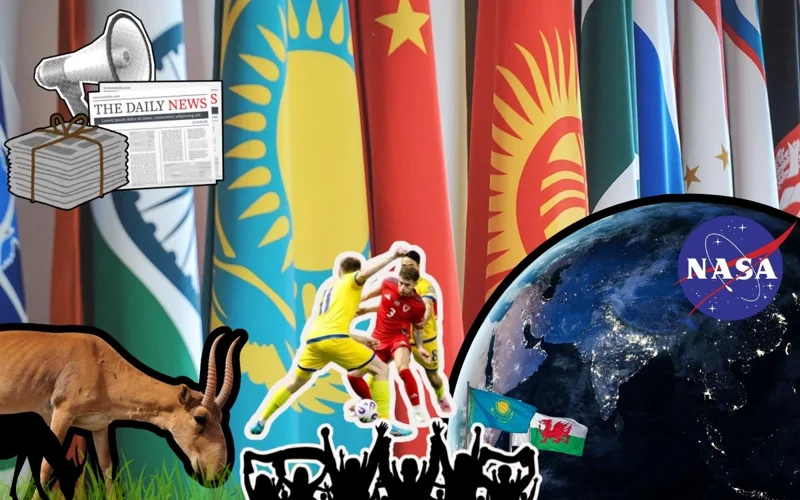Foreign media on Kazakhstan: From Silk Road to Belt and Road: China–Kazakhstan example of partnership; NASA satellites captured rare geological movement In Kazakhstan
Based on recent developments, including Kazakhstan strengthening cooperation with China through the SCO, NASA satellites capturing a rare geological movement in western Kazakhstan, and the extraordinary story of a Wales super-fan traveling nearly 5,000 kilometres to attend a World Cup qualifier in Astana, Kazinform News Agency presents a weekly review of the country’s coverage in foreign media.

Eureporter: From the Silk Road to the Belt and Road: The China–Kazakhstan example of partnership
The 25th anniversary summit of the Shanghai Cooperation Organization (SCO) opened on 31 August in Tianjin, China. President Kassym-Jomart Tokayev attended, underscoring Kazakhstan’s role as a founding member and key regional partner, Eureporter reports.
In a recent article for China Daily, Tokayev highlighted that China and Kazakhstan share a “1,700-kilometer peaceful and friendly border” and have developed relations into “a partnership with strong ties and a model of strategic cooperation.”
Since establishing diplomatic relations in 1992, the two countries have steadily deepened their cooperation. Trade reached a record USD 44 billion in 2024, making China Kazakhstan’s largest economic partner.
“Since 2005, Chinese enterprises have invested over $27 billion in Kazakhstan, with nearly 6,000 companies operating in our country today — playing a vital role in technological advancement and industrial modernization,” Tokayev noted.
Kazakhstan has also become a major transit hub in Eurasia. “The launch of additional Dostyk-Moyynty railway lines will boost Kazakhstan's transit capacity along the China-Europe corridor fivefold,” Tokayev said, also pointing to joint maritime projects with China’s Lianyungang port.
Energy remains central: in 2023 China imported 6.41 million tons of crude oil and 5.8 billion m³ of natural gas from Kazakhstan.
At the SCO summit, Tokayev reaffirmed support for the organization’s principles: “Kazakhstan fully supports the SCO’s core goals: an equitable multipolar world order, security and stability, non-interference in internal affairs, recognition of sovereign development, fair international trade, and mutually beneficial investment cooperation.”
As founding members, Kazakhstan and China view the SCO as “a cornerstone of multilateral cooperation in Eurasia,” Tokayev stressed, fostering stability, economic growth, and cultural exchange.
IDR: NASA satellites captured rare geological movement In Kazakhstan
According to IDR, a colossal sandy formation, nicknamed the “sandy slug,” is slowly crawling across the floodplains of western Kazakhstan, documented in striking detail by NASA’s Earth Observatory. The Oyyl dune field offers a rare glimpse into a geological process that is neither a typical desert dune nor a static sediment pile but a viscous body creeping across the flatland.
Scientists say the slug advances “meters per year,” its movement driven by seasonal snowmelt, floodwaters, and prevailing winds. During spring and summer, water lubricates the sand, creating ridges and depressions that mark active sediment transport. In autumn, the process slows before winter immobilizes the mass entirely, as ice locks the dune in place until thawing resumes migration.
High-resolution imagery from Landsat and Sentinel satellites has been instrumental in tracking its path. NASA’s images reveal elongated shapes and consistent directional flow, confirming that the dune responds to subtle gradients and wind rather than random shifts. Researchers describe the Oyyl dune field as a “natural laboratory” for studying sediment transport and floodplain evolution in semi-arid regions.
Beyond scientific curiosity, the slug influences its environment: altering drainage, reshaping wetlands, and affecting soil moisture vital for vegetation and wildlife. Climate shifts in snowmelt and rainfall could accelerate or halt its pace, with implications for agriculture and water resources.
As NASA imagery shows, the sandy slug is more than a local oddity — it is a window into the dynamic forces quietly reshaping Earth’s surface, offering insights into past and present geomorphological processes.
The Times of Central Asia: Kazakhstan gifts 1,500 saiga antelopes to China
Kazakhstan has gifted 1,500 saiga antelopes to China, supporting Beijing’s effort to restore the species, which has been extinct there for decades, The Times of Central Asia reports.
Once critically endangered at home with just 40,000 animals in 2005, Kazakhstan’s saiga population has now reached a record 4.1 million in 2025, creating ecological imbalances. The transfer helps ease overpopulation while strengthening environmental diplomacy.
China has attempted before to revive saigas without success. Ecologist Dastan Kusmanov of Nazarbayev University told The Times of Central Asia: “If a new saiga population is established in China, this is an overall benefit for the species’ survival, because if anything happens to the existing saiga population in Kazakhstan, the species still has a chance to survive elsewhere.”
He added that saigas are vital for ecosystems: “You need ungulate animals for the benefit of the environment. They eat grass, trample soil, spread seeds through excrement, and serve as a food source for wolves and eagles.”
Dr. Kanat Baigarin, Chief Officer for Sustainable Development at Nazarbayev University, emphasized the broader value: “The more widely the saiga population is distributed, the more resilient it becomes to epidemics and other threats. This is a unique example of how countries can work together to restore endangered species.”
The Guardian: One man’s odyssey and a Hollywood striker get Wales fired up for Kazakhstan
Wales head coach Craig Bellamy praised the extraordinary effort of super-fan John McAllister, who has travelled nearly 5,000 kilometres over five weeks to watch Wednesday’s World Cup qualifier in Astana, The Guardian reports.
McAllister set off from Barry, taking 17 trains, 11 buses and a reluctant flight through 12 countries, fitting in “11 football matches, no end of foreign boozers, a heavy metal gig and some Irish stranger’s stag do” along the way. Bellamy called it “a bonkers odyssey,” adding: “We’ve got to see him, because it means so much to us. I’m beyond proud of that fact.”
Around 1,000 Wales fans will join him in Kazakhstan, though most opted for a more direct route. Bellamy said their devotion inspires the team: “They look after each other, they’re well behaved but they enjoy themselves. We want to be like that, we want to play like that.”
Wales, second in Group J, must win against opponents ranked 83 places below them, having already beaten Kazakhstan in Cardiff. Celtic’s recent defeat to Kairat Almaty served as a warning, but Bellamy remains confident.
For the first time in 15 years, Wales will also feature a player from Wrexham, the Hollywood-backed club that has captured imaginations. “I think we’re all captivated by the journey of Wrexham,” said Bellamy. “The better they do, the better chance we have of being a stronger nation in football.”
You can read last week’s weekly digest here.
